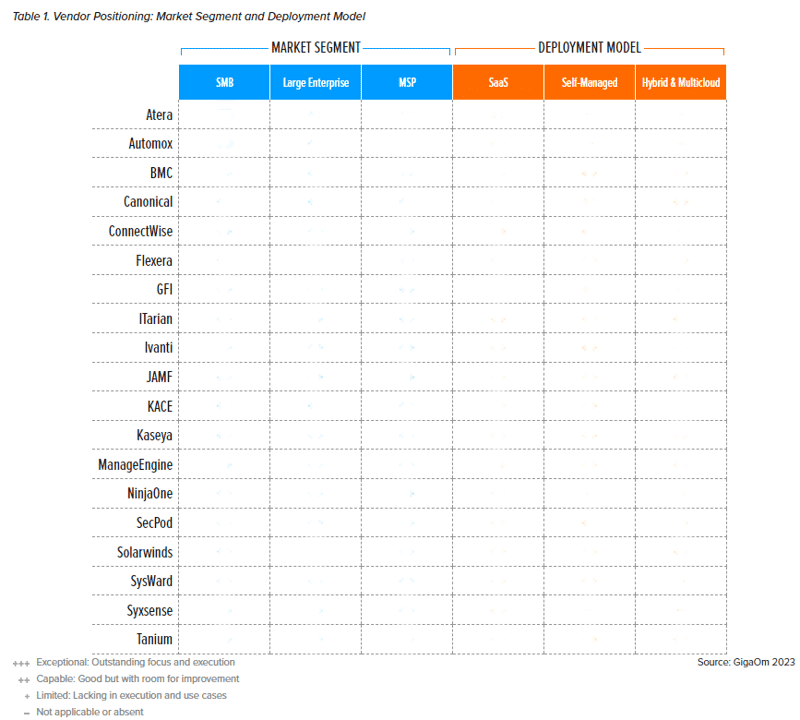
Despite the technological advancements in today’s digital landscape, patch management still poses significant challenges. This is largely due to the increasing complexity of IT infrastructures, which often comprise a mix of on-premises, cloud, and hybrid environments, as well as a variety of devices and operating systems. Added to this is the sheer volume of patches being released, making it difficult for IT teams to keep up. Furthermore, the lack of clear visibility into the organization’s IT assets and their current patch status complicates the process. This scenario underscores the importance of choosing a versatile and comprehensive patch management solution.
But with several vendors in this space, it’s not always easy to identify which solution is best for you. That’s where GigaOm’s Radar Report for Patch Management comes in. This report provides a comprehensive evaluation framework that can help businesses select the right patch management solution for their specific needs.
In this blog series, we’ll leverage GigaOm’s Radar Report on Patch Management to highlight what you should look for in a patch management solution, some key criteria for evaluating vendor capabilities, and metrics you should consider as you conduct an evaluation.
Start with your operating environment
If your organization operates 100% in-person with all endpoints on corporate premises, that will be a critical factor in choosing a patching solution. We now see hybrid environments as the norm, especially given the rise of work-from-anywhere policies. If your organization also operates in a hybrid environment, you may want to consider deployment models that support this kind of flexibility. GigaOm outlines three models:
- SaaS: deployed and managed by the software vendor, this deployment model typically offers greater integration capabilities and can more easily scale.
- Self-managed: deployed only on customer-owned infrastructure and managed by internal teams.
- Hybrid and multicloud: can support on-premise installation and/or in the cloud. Can offer greater flexibility but requires more resource planning, for both tuning and infrastructure.

GigaOm Radar on Patch 2023 Management market segment and deployment table
Table details are redacted, per vendor usage restrictions. To see the full table, please download the report.
Understand your IT infrastructure to determine your patching needs
Next, understanding the intricacies of your IT infrastructure is pivotal in identifying the optimal patch management solution. Your IT infrastructure’s scale, complexity, and the types of devices and operating systems it encompasses can remarkably influence the capabilities you require in a patch management tool.
GigaOm notes in their report: “Most organizations patch laptops, desktops, and servers in an ad hoc manner, so a patch management solution can add rigor and consistency to what may already be in place. When searching for a solution, companies should evaluate the coverage that already exists in their organization, so they can assess and address any gaps.”
For instance, if your infrastructure includes a wide variety of devices and operating systems, a multi-platform/multi-OS patch management solution, which provides extensive cross-platform compatibility, could be an excellent fit. A thorough understanding of your IT infrastructure is necessary when looking for a patch management solution that can effectively cater to your organizational needs.
In our conversations, we often find that enterprises may be using one product to patch Windows machines and another one for their Mac devices and yet another for Linux systems. This fragmented approach is neither cost-effective nor efficient. While it may have been necessary in the past, new patching solutions have made strides in enabling patching from one console. A single solution that can patch all your assets, regardless of the operating system or device type, streamlines the entire process and saves you time, money, and resources.
In the GigaOm Radar Report, GigaOm analysts call this “patch coverage” and highlight vendors’ capabilities across the following systems:
- Desktop: Windows
- Desktop: macOS
- Desktop: Linux
- Server: Windows
- Server: Linux
- Mobile: iOS
- Mobile: Android
- Remote Systems
A thorough chart identifies which vendors have no, limited, capable, or exceptional patching capabilities across these areas. For your organization, consider how much support you would need across these operating systems. You may only need coverage for Windows clients and servers. But other organizations may need support across all of them. If that’s the case, finding one vendor that has capable or exceptional support across all the systems could be ideal for saving time and reducing costs.
Up next: key criteria and evaluation metrics
In the next blog post in this series, we’ll cover additional research from GigaOm that you can use to guide a vendor or software search for patch management support. Stay tuned for more insights on how to choose the best patch management solution for your organization, including factors like scalability, flexibility, automation, and cost-effectiveness.
If you want to get complimentary access to the report, courtesy of Syxsense, download it here.






